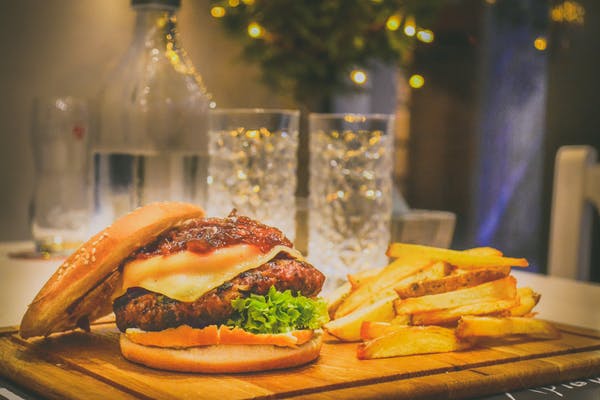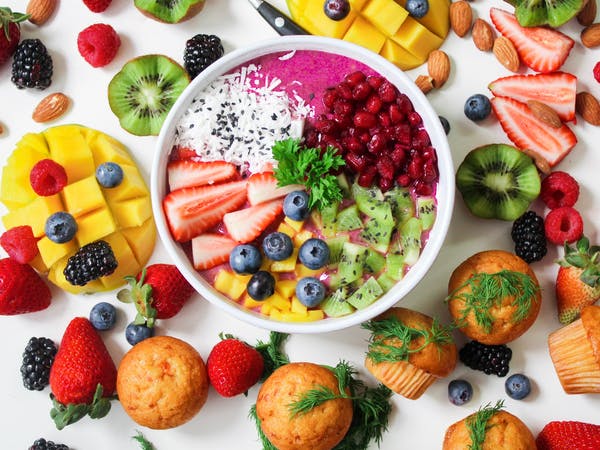Glycemic Index: A Quick Snapshot
The Glycemic Index (GI) is a measure of how quickly a food causes our blood sugar levels to rise. It is a number or value assigned to foods, based on how much they increase blood sugar levels. Foods are ranked on a scale of 1-100 depending on how quickly they raise your blood sugar level compared to either glucose or white bread, which are assigned a value of 100. To assign a GI number, foods are slotted into three categories; low, medium or high:
- Low GI foods: Foods with a value of 55 or less. Some examples of low GI foods include green vegetables, most fruits, lentils, kidney beans, and chickpeas
- Medium GI foods: Foods with a value between 56-69. For example: sweet corn, bananas, raisins, whole-grain wheat bread
- High GI foods: Foods with a value of 70 or above, such as white rice, potatoes and white bread
Foods that do not contain carbohydrates are not assigned a GI, for example, meat, poultry, fish, nuts, seeds, spices, herbs and oils. You can think of the glycemic index as a nutritional tool that you can use to determine how a specific food will impact your blood sugar. It is a good way to increase awareness of the different foods you’re eating and can also help with weight management, managing blood sugar levels and reducing cholesterol. The Harvard Health Publication provides an abbreviated chart of the glycemic index for over 60 common foods here.
Things To Keep In Mind When You Use The Glycemic Index
There are many factors which can change the glycemic index of a food. These include:
- Cooking Time: The longer a food is cooked, the higher it tends to be on the GI
- Ripeness: The more ripe a fruit or vegetable, the higher it tends to be on the GI
- Acidity: Foods that are highly acidic tend to be lower on the GI. Breads made with lactic acid, such as sourdough bread are lower on the GI than white bread
- Fiber Content: In general, foods that are high on fiber, tend to have a lower GI
- Processing: The more processed a food is, the higher it is on the GI scale
Fast Fact: A good thumb rule to follow is that the closer a food is to how it is found in nature, the lower it is on the GI as opposed to foods that are highly processed.
There are a couple of other things you need to keep in mind when using the GI as a nutritional tool. For one, a food’s GI ranking only applies when it is consumed on an empty stomach and without any other type of food. This may not hold true for the majority of the meals you consume during the course of a typical day.
Further, the glycemic index does not take portion sizes into account. The GI value of a fruit like pineapple, for example, is 58, putting it in the medium GI food category. However a half-inch thick slice of pineapple contains about 7 grams of carbs which means a couple of slices probably will not cause a dramatic spike in your blood sugar. Similarly, carrots have a high glycemic index, but you would have to eat over half a kilo of carrots to get the amount measured for carrots’ GI.
A different measure called the Glycemic Load may be a better way to measure the impact a carbohydrate food has on blood sugar.
What is the Glycemic Load?

Glycemic Load (GL) is a measure that factors in the typical serving size of a food as well as the speed of digestion. For example, the GI value of a cantaloupe is between 65-70, but it factors in approximately one medium sized cantaloupe to arrive at this value. The GL on the other hand would factor in the typical serving size, i.e. about one-third of a medium sized cantaloupe and assign it a GL value of 11 or lower.
The glycemic load therefore corrects for the GI by combining portion size and GI into one number. The glycemic load is calculated by multiplying the carbohydrate content of the actual serving size of a food with that food’s GI and dividing the result by 100. The GL values of foods are also classified into 3 categories as follows:
- Low GL foods: Foods with a value of 10 or less
- Medium GL foods: Foods with a value between 11 and 19
- High GL foods: Foods with a value greater than 20
Glycemic load factors in both the quality as well as the quantity of the carbs you eat. Foods like whole grains, fruits, vegetables (without starch), legumes, nuts and other low GI foods make up a diet with a lower glycemic load. So make sure you eat plenty of these and go easy on high GI foods like white rice, white bread and potatoes. Sugary foods like cakes, cookies, candy, and sugary drinks are best avoided or minimized.
What are the benefits of using the Glycemic Index?

Using the glycemic index as a nutritional tool has several benefits. It can help you manage your blood sugar levels by choosing foods with low GI values; although you also have to be mindful of your portion sizes. This is especially useful for those dealing with type 1 or type 2 diabetes, as you can keep your blood sugar levels from going too high or too low. It can also help to lower the risk of diabetes and heart disease, and manage your cholesterol and blood pressure levels.
You can also use the GI index if you’re trying to manage your weight, since low GI foods take longer to digest and will help you feel fuller for longer. The GI is also a helpful tool to plan healthier meals since it helps you determine appropriate combinations of foods. Pairing a high GI food with several low GI foods brings down the overall GI load of the meal and helps to maintain better blood sugar control. Examples include pasta with a tomato basil sauce and vegetables, toast with almond butter and the good old rajma chawal.
Good To Know: You can continue to enjoy high GI foods. Just remember to eat smaller portions and pair them with nutritious low GI foods.
Are there any risks of using the Glycemic Index?
The glycemic index does not take into account the overall nutritional value of a food. For example, whole milk has a low GI and GL value but it is high in both fats and calories. Similarly, cantaloupe has a mid-high GI score and a medium GL score but it is rich in vitamin C and beta carotene.
Also, the published GI database of foods is not a complete list of foods. It only includes those foods that have been studied. Many nutritious foods with low GI values may not be in the list at all. The list also includes highly processed foods which may have low GI values but are also low on nutritive value.
Takeaway
The glycemic index is a useful nutritional tool to help you make better food choices. It can help you to choose nutritionally dense foods and make consistently healthy food choices. Remember to include a variety of fruits and vegetables, whole grain foods, nuts, lentils, seeds, beans and legumes as part of a healthy diet. Based on your dietary preferences and requirements, lean meats, fish and dairy are good choices too. Apart from food; getting adequate sleep, regular exercise and reducing stress are essential for a healthy lifestyle.
